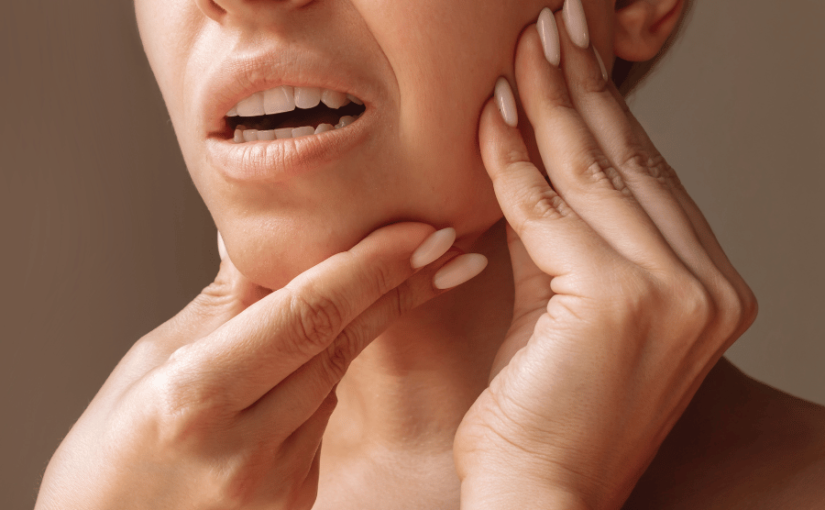By: Dr. Elizabeth Eggert
You’ve probably heard of TMJ, but the term is commonly misused. TMJ refers to the temporomandibular joint in your jaw or where your jaw opens and closes. What people often refer to as TMJ is actually TMJ disorder or TMD. When it comes to oral health, it’s critical to understand what TMD is, how it can present, and what you can do if you suspect TMD is an issue for you.
What is TMD?
When things are properly aligned and working as they should, we don’t give our temporomandibular joints a second thought. They are two of our body’s many unsung heroes. However, anytime you yawn, speak, or chew, you can thank your TMJs for making it possible!
Unfortunately, our jaw joints and the muscles and ligaments surrounding them can cease to work properly, resulting in jaw clicking, jaw and facial pain, and a cascade of other issues. 5-12% of people deal with TMD at some point in their lives.
What Causes TMD?
There is no singular cause of TMD. Instead, several conditions can result in a misaligned jaw and issues with the temporomandibular joints.
These include:
- A jaw injury (often from sports or a car accident)
- Malocclusion
- Sleep apnea
- Bruxism
- Stress
Additional causes or activities that can aggravate TMD include:
- Oral habits, like chewing on pencils, fingernails, ice, etc.
- Poor posture
- Stomach sleeping
Common Symptoms of TMD
Even though jaw and face pain are common symptoms, they’re not always present, or they’re accompanied by other seemingly unrelated symptoms.
Common symptoms include:
- Jaw and facial pain
- Jaw stiffness
- Difficulty opening and closing your mouth
- Jaw popping, clicking, or locking
- Neck or shoulder pain
- Pain behind the eyes
- Back pain
- Toothache or earache
- Headaches or especially migraines
- Dizziness
- Ear ringing (tinnitus)
- Teeth sensitivity with no other detectable causes
- Loose teeth
- Receding gums
- Worn down or cracked teeth
Diagnosing TMD
If you have one or several of these symptoms and are suspicious that you’re dealing with TMD, make an appointment with Dr. Elizabeth Eggert or Dr. Jeff Eggert. They will explore your health history, perform a dental exam, and take any necessary imaging to diagnose or rule out TMD. During your dental exam, they will observe and feel your jaw joints and muscles when you open and close your mouth and may press on your face and jaws to test for areas of sensitivity.
Treatment Options for TMD
TMD treatment runs the gamut:
- Pain relievers, NSAIDs, and muscle relaxers can help with day-to-day discomfort. For some people, however, the pain is persistent, and over-the-counter and prescription meds don’t cut it. They’re dealing with other bothersome symptoms and need a more proactive approach. This medicinal approach works best for short-lived or acute TMD issues.
- Custom oral splints can relieve tension in the jaw and keep it properly aligned, reducing clenching and grinding.
- Botox injections help relax jaw muscles and can lessen jaw discomfort. However, Botox will need to be repeated about every 3 months to maintain relief. Instead of Botox long-term, it is usually best to work to figure out the actual diagnosis of what is happening with your joint and look to make dental changes that can work for long-term relief.
- If stress is the underlying cause of TMD, stress-management techniques such as exercise, meditation, and breathwork can get to the root of the problem.
- If the atlas, or C1 vertebrae is out of alignment and causing the jaw to be misaligned, working with an upper cervical (NUCCA) chiropractor can be an effective way to realign the jaw and alleviate TMD symptoms.
- After an oral exam and x-rays, Dr. Elizabeth Eggert or Dr. Jeff Eggert may determine you’re a good candidate for occlusal equilibration. Occlusal equilibration involves subtly and precisely reshaping the biting surfaces of the teeth to correct the alignment of the bite and the position of the jaw. This process allows jaw muscles to relax and reduces or eliminates pain and sensitivity.
- Orthodontics can also be an effective way to change tooth positions and your bite to help alleviate the muscle and joint strain of TMD.
- In severe cases when less invasive treatments and techniques don’t alleviate TMJ issues, TMJ surgery may be required. Arthroscopy, arthrocentesis, and open-joint surgery are two surgical approaches to TMD.
Prevention for TMD
A recent NIDCR study identified clinical, psychological, sensory, genetic, and nervous system factors that may increase a person’s risk for TMD. In other words, while it’s treatable, it isn’t always avoidable. However, there are a few precautions you can take to reduce the likelihood of developing TMD.
- Don’t stomach sleep. Sleep in a position that properly supports your head, neck, and spine.
- Maintain good posture. Utilize physical therapy or chiropractic treatments to stay in alignment or consider yoga with a certified instructor.
- Practice stress-reduction techniques.
- Be mindful of chewing. Don’t chew on inanimate objects like pencils and don’t chew your fingernails. Avoid taking huge bites of food and overextending your jaw. Minimize or eliminate gum chewing.
- Schedule routine recare visits at Eggert Family Dentistry!
If you’re experiencing bothersome symptoms and suspect you’re dealing with TMD, Dr. Elizabeth Eggert and Dr. Jeff Eggert of North Oaks, MN will perform a TMD evaluation. If they detect TMD, they’ll create a personalized treatment plan that realigns your jaw and alleviates pain. Give us a call at 651.482.8412 to schedule your appointment!
